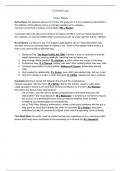Summary
Summary OCR A Level Law: Criminal Law Revision Notes
- Institution
- OCR
Comprehensive All you need to know for the OCR A Level Law Paper 1, Section B: Criminal Law from an A* Student All Cases and Legislation included and all substantive topics covered.
[Show more]



